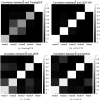Evaluating Model Misspecification in Independent Component Analysis
- PMID: 25642002
- PMCID: PMC4309392
- DOI: 10.1080/00949655.2013.867961
Evaluating Model Misspecification in Independent Component Analysis
Abstract
Independent component analysis (ICA) is a popular blind source separation technique used in many scientific disciplines. Current ICA approaches have focused on developing efficient algorithms under specific ICA models, such as instantaneous or convolutive mixing conditions, intrinsically assuming temporal independence or autocorrelation of the sources. In practice, the true model is not known and different ICA algorithms can produce very different results. Although it is critical to choose an ICA model, there has not been enough research done on evaluating mixing models and assumptions, and how the associated algorithms may perform under different scenarios. In this paper, we investigate the performance of multiple ICA algorithms under various mixing conditions. We also propose a convolutive ICA algorithm for echoic mixing cases. Our simulation studies show that the performance of ICA algorithms is highly dependent on mixing conditions and temporal independence of the sources. Most instantaneous ICA algorithms fail to separate autocorrelated sources, while convolutive ICA algorithms depend highly on the model specification and approximation accuracy of unmixing filters.
Keywords: Convolutive Mixing; Independent Component Analysis; Model Misspecification.
Figures







Similar articles
-
Model selection for convolutive ICA with an application to spatiotemporal analysis of EEG.Neural Comput. 2007 Apr;19(4):934-55. doi: 10.1162/neco.2007.19.4.934. Neural Comput. 2007. PMID: 17348768
-
Convolutive bounded component analysis algorithms for independent and dependent source separation.IEEE Trans Neural Netw Learn Syst. 2015 Apr;26(4):697-708. doi: 10.1109/TNNLS.2014.2320817. IEEE Trans Neural Netw Learn Syst. 2015. PMID: 25794376
-
Convolutive blind source separation algorithms applied to the electrocardiogram of atrial fibrillation: study of performance.IEEE Trans Biomed Eng. 2007 Aug;54(8):1530-3. doi: 10.1109/TBME.2006.889778. IEEE Trans Biomed Eng. 2007. PMID: 17694875
-
[Independent Components Analysis (ICA) in the study of electroencephalographic signals].Neurologia. 2005 Jul-Aug;20(6):299-310. Neurologia. 2005. PMID: 16007513 Review. Spanish.
-
Independent component analysis for biomedical signals.Physiol Meas. 2005 Feb;26(1):R15-39. doi: 10.1088/0967-3334/26/1/r02. Physiol Meas. 2005. PMID: 15742873 Review.
References
-
- Vigário R, Sarela J, Jousmiki V, Hamalainen M, Oja E. Independent component approach to the analysis of eeg and meg recordings. Biomedical Engineering, IEEE Transactions on. 2000;47(5):589–593. - PubMed
-
- Cardoso J, Souloumiac A. Radar and signal processing, iee proceedings f. Vol. 140. IET; 1993. Blind beamforming for non-gaussian signals; pp. 362–370.
-
- Bell A, Sejnowski T. An Information-Maximization Approach to Blind Separation and Blind Deconvolution. Neural Computation. 1995;7(6):1129–1159. - PubMed
-
- Lee T, Girolami M, Sejnowski T. Independent Component Analysis Using an Extended Infomax Algorithm for Mixed Subgaussian and Supergaussian Sources. Neural Computation. 1999;11(2):417–441. - PubMed
Grants and funding
LinkOut - more resources
Full Text Sources
Other Literature Sources
Miscellaneous
